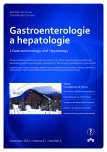The importance of endoscopic retrograde cholangiopancreatography in adolescent patient with traumatic rupture of pancreatic duct
Authors:
J. Lochmannová 1; R. Keil 1; L. Douda 1; J. Drábek 1; J. Šťovíček 1; J. Chudý 1; M. Rygl 2; J. Šnajdauf 2; O. Petrů 2
Authors‘ workplace:
Interní klinika 2. LF UK a FN v Motole, Praha
1; Klinika dětské chirurgie 2. LF UK a FN v Motole, Praha
2
Published in:
Gastroent Hepatol 2013; 67(6): 474-478
Category:
Digestive Endoscopy: Case Report
Overview
The traumatic injury of the pancreatic duct in children is rare and almost in every cases is connected with an existing injury of the pancreatic parenchymal tissue. The most frequent reason is a blunt abdominal trauma. If there is a suspicion of the pancreatic duct injury, the endoscopic retrograde cholangiopancreatography is indicated to map the pancreatic ductal system. If the pancreatic duct leasion is approved one of the treatment strategies which can be considered is the intraductal placement of the pancretic stent. The authors describe a case of a 14-year-old child with a traumatic pancreatic duct injury after a blunt abdominal trauma in who the urgent ERCP with a placement of the pancreatic stent was undertaken.
Key words:
rupture – pancreatic duct – endoscopic retrograde cholangiopancreatography – Sandostatin – posttraumatic pseudocyst
The authors declare they have no potential conflicts of interest concerning drugs, products, or services used in the study.
The Editorial Board declares that the manuscript met the ICMJE „uniform requirements“ for biomedical papers.
Submitted:
18. 4. 2013
Accepted:
18. 11. 2013
Sources
1. Wolf A, Bernhardt J, Patrzyk et al. The value of endoscopic diagnosis and the treatment of pancreas injuries following blunt abdominal trauma. Surg Endosc 2005; 19(5): 665–669.
2. Lin BC, Chen RJ, Fang JF et al. Management of blunt major pancreatic injury. J Trauma 2004; 56(4): 774–778.
3. Jobst MA, Canty TG Sr, Lynch FP. Management of pancreatic injury in pediatric blunt abdominal trauma. J Pediatr Surg 1999; 34(5): 818–823; discussion: 823–824.
4. de Blaauw I, Winkelhorst JT, Rieu PN et al. Pancreatic injury in children: good outcome of nonoperative treatment. J Pediatr Surg 2008; 43(9): 1640–1643.
5. Houben CH, Ade-Ajayi N, Patel S et al. Traumatic pancreatic duct injury in children: minimally invasive approach to management. J Pediatr Surg 2007; 42(4): 629–635.
6. Moore EE, Cogbill TH, Malangoni MA et al. Organ injury scaling, II: Pancreas, duodenum, small bowel, colon, and rectum. J Trauma 1990; 30(11): 1427–1429.
7. Canty TG Sr, Weinman D. Management of major pancreatic duct injuries in children. J Trauma 2001; 50(6): 1001–1007.
8. Bosboom D, Braam AW, Blickman JG et al. The role of imaging studies in pancreatic injury due to blunt abdominal trauma in children. Eur J Radiol 2006; 59(1): 3–7.
9. Keil R, Snajdauf J, Stuj J et al. Endoscopic retrograde cholangiopancreatography in infants and children. Indian J Gastroenterol 2000; 19(4): 175–177.
10. Keil R, Snajdauf J, Stuj J et al. Nonoperative therapy of the posttraumatic biliary fistula in adolescents. Eur J Pediatr Surg 2001; 11(4): 274–276.
11. Wood JH, Partrick DA, Bruny JL et al. Operative vs nonoperative management of blunt pancreatic trauma in children. J Pediatr Surg 2010; 45(2): 401–406.
12. Cay A, Imamoglu M, Bektas O et al. Nonoperative treatment of traumatic pancreatic duct disruption in children with an endoscopically placed stent. J Pediatr Surg 2005; 40(12): e9–e12.
13. Duchesne JC, Schmieg R, Islam S et al. Selective nonoperative management of low-grade blunt pancreatic injury: are we there yet? J Trauma 2008; 65(1): 49–53.
14. Takishima T, Hirata M, Kataoka Y et al. Pancreatographic classification of pancreatic ductal injuries caused by blunt injury to the pancreas. J Trauma 2000; 48(4): 745–751.
15. Wensil AM, Balasubramanian SA, Bell TL. Resolution of a posttraumatic pancreatic pseudocyst with octreotide acetate in a pediatric patient. Pharmacotherapy 2011; 31(9): 924.
Labels
Paediatric gastroenterology Gastroenterology and hepatology SurgeryArticle was published in
Gastroenterology and Hepatology

2013 Issue 6
- Metamizole vs. Tramadol in Postoperative Analgesia
- Metamizole at a Glance and in Practice – Effective Non-Opioid Analgesic for All Ages
- Possibilities of Using Metamizole in the Treatment of Acute Primary Headaches
- Current Insights into the Antispasmodic and Analgesic Effects of Metamizole on the Gastrointestinal Tract
- Spasmolytic Effect of Metamizole
Most read in this issue
- Diagnosis of disorders of gastric emptying in diabetic patients with diabetic autonomic neuropathy
- Endoscopic resolution of refractory postoperative bile leak from bile duct with fully covered self-expandable metallic stent
- Guidelines of the Czech gastroenterological society – endoscopic treatment of Barrett´s esophagus and early esophageal neoplasia
- Hepatocellular carcinoma – our experience with surveillance, effect and complications of transarterial chemoembolization
